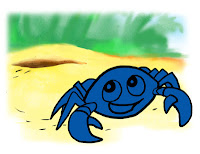How did you become the illustrator of JOE THE CRAB? Tim and I met at the Saint Louis Publishers Association field trip to No Waste Publishing out in Fenton. After the introductions and a tour of the facility, Tim came and asked me if I could draw a crab. Later that week we discussed the project over coffee and cinnamon rolls and by the end of the meeting we were in business.
Collaboration can be tricky. Did you do the illustrations after the copy was finished or was it more interactive? Tim worked really hard on the copy before we started, but we did collaborate on the text while we were working together on the layout. As illustrator it's my job to bring his story to life, so before production started we sat down together and planned every page as a team, that way I knew the art I was making fit Tim's vision for the story.
Do you have a different thought process when you illustrate than when you write? Drawing is more natural for me. Once I have a rough outlined I can work on an illustration project anywhere, anytime despite distraction.Writing requires more time and concentration. I can finish three pages of text in a matter of days or three illustrations in a matter of hours. In the end both are used to tell stories, and being able to do both helps me draw more narrative images and write more visual prose.
What advice do you have for writers/illustrators of children's books? Collaborate. As an illustrator you are bringing the author's vision to life, it's important to listen to their prompts and their feedback. Authors need to listen to their illustrators as well. If your artist has an issue with the idea or composition you ask for remember that they are professionals as well. Together the two of you can make something great.
What medium do you use (watercolor, acrylic, etc)? My work's purely digital. I used a Wacom Intuos 4 drawing tablet and Photoshop CS5 to complete the images for JOE THE CRAB TAKES A WALK. Working on the computer, I have access to a wider variety of brushes and colors. It frees the mind to experiment and take risks with the art; you can isolate bits, move them around, paint underneath them or mask them out completely - and if you're not happy just press 'undo' and it's like nothing ever happened. I'm able to take Tim's critique and apply it directly to the image then ship that off to the printer without missing a beat.
Would you describe the process for us?
Illustrations start with Tim and I sitting down and fleshing out a rough image. We usually rough out the whole book in a sitting, then I go away and use the roughs to make the images.

The backgrounds lay in first, then linework. The flat color is applied on a layer below the lines so the two can be edited separately.
Finally I apply shading and affects to the flat color. I have a reference sheet for each character with notes on what colors, brushes, and blending options I use to achieve the final look - so that every image is consistent. Joe's final look is the result of four to six detail layers stacked on top of each other. I paint the eyes and mouth on a separate layer on top of that for easy editing later.
Is your style inspired by another illustrator? My style is heavily influenced by the cartoons and comics I enjoyed as a child. Studios like Disney, Hanna Barbara, and Toei Animation entertained me for hours with bold lines, color and facial expressions.
Critique groups are important to writers. Is there anything similar for illustrators? It always helps to ask for an outside opinion. If you're having trouble with anatomy or blocking in an image, another artist whose eye you trust is invaluable. I often worked on Joe the Crab alongside a friend and used them for a second opinion. Tim and I were our own little critique group, but I but as far as structured feedback groups
go, it's not quite the same.
What resources have helped you as an illustrator? The technology and software of the digital age have really broadened my horizons as an illustrator, but nothing beats drawing from life. I've taken various classes and attended special events to keep my practical skills up to snuff. I especially love figure drawing. I highly recommend illustrators investigate their local artists guilds and community colleges for low-priced art classes to flex their muscles.
Where can we find samples of your animation? You can find my demo reel and my award-winning short Dog Park on my website or here are direct links:
Tell us about your current project(s). We're currently working hard at getting the second Joe book to print. The process is much smoother the second time around, I'm excited to see how it turns out!
And your novel? Info about my young adult novel, THREADCASTER, is available at www.threadcaster.com and @Threadcaster on both Twitter and Facebook.
How can people who need illustration find you? They can email me at jenniferstolzer@gmail.com to talk about projects and rates. To see examples of my work they can visit my website at www.jenniferstolzer.com
Thanks for reading The Writers' Lens. Comment to enter this week's giveaway of R.D. Pittman's NEW EARTH trilogy.
This is T.W. Fendley. You can find me at www.twfendley.com and on Twitter @twfendley.





Great interview. Jennifer, love your style of illustrating... that is from this blog post. I'm going to check out your other material! Thanks.
ReplyDelete